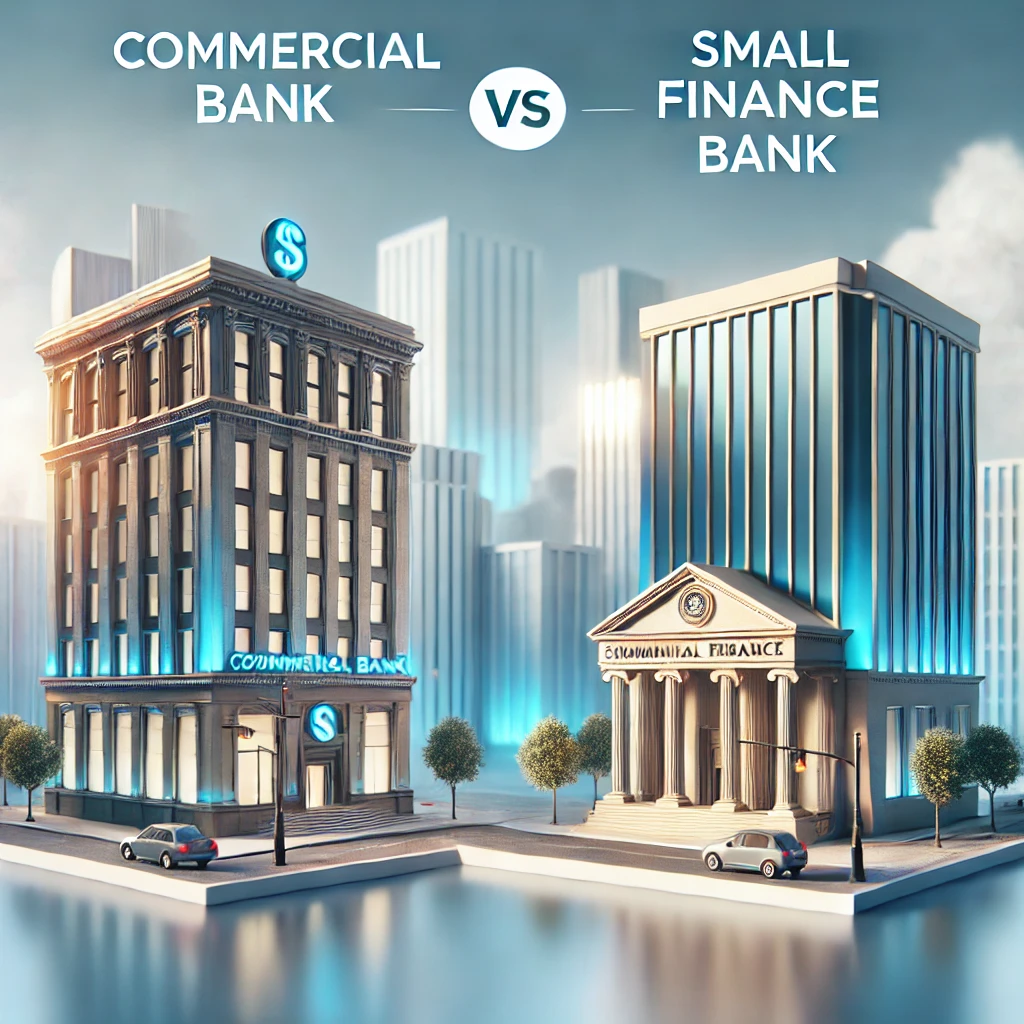The difference between commercial bank and small finance bank is mainly in purpose, scale, target clientele, and services. While commercial banks reach a wide variety of customers from individuals to corporations banks are created specifically for underserved and unbanked populations, especially in the rural regions. This gives way to differences in structure, objectives, and regulation.
What is Commercial Bank?
Commercial banks are financial intermediaries that accept deposits, lend money, and provide other finance-related services to individuals, businesses, and governments. They are very important in economic activities because they mobilize savings and facilitate investment. Commercial banks are regulated in the country by the country’s central bank, which would ensure stability and trust in the financial system.
Functions of Commercial Banks
Commercial banks perform several key functions, such as:
- Accepting deposits from customers in the form of savings accounts, current accounts, and fixed deposits.
- Provision of loans to individuals, businesses, and industries for boosting economic activities.
- Aiding international trade by issuing letters of credit and managing foreign exchange.
- Provision of modern banking services such as internet banking, mobile banking, and credit card facilities.
Nature of Commercial Banks
The nature of commercial banks is to produce profit, economic development, and financial inclusion. It is an integral part of a country’s financial system, connecting the saver to the borrower in an efficient manner. d d
Characteristics of Commercial Banks
- Profit Orientation: Commercial banks operate to generate the maximum possible profits for their shareholders by lending at a higher interest rate than they are paying on deposits.
- Extensive Services: From basic savings accounts to complex financial instruments, commercial banks provide an array of services.
- Risk Management: Employ sophisticated techniques to manage credit, operational, and market risks.
- Massive Operations: They cater to millions of customers spread across regions with the latest technological infrastructure.
Examples of Commercial Banks
- State Bank of India (SBI)
- ICICI Bank
- HSBC
- Citibank

What is Small Finance Bank?
Small finance banks are financial institutions that have been established to cater to the financial needs of the underbanked and unbanked population. These banks are smaller compared to commercial banks, as they focus on microloans, small savings, and financial inclusion initiatives.
Functions of Small Finance Banks
Small finance banks fulfill the following roles:
- Provide banking services to rural and semi-urban populations.
- Offer microloans to small businesses, farmers, and self-help groups.
- Encourage saving habits by offering higher interest rates on deposits.
- Empower local economies by facilitating financial access.
Objectives of Small Finance Banks
The objectives of small finance banks are aligned with promoting inclusive growth, ensuring financial stability, and bridging gaps in access to banking services for neglected segments of society.
- Financial Inclusion: Cater to unbanked regions by providing access to credit and deposit facilities.
- Economic Empowerment: Support small-scale businesses and entrepreneurs through loans and advisory services.
- Regional Focus: Target underdeveloped and rural areas to reduce regional disparities.
- Encourage Savings: Promote savings among lower-income groups by offering attractive interest rates.
Examples of Small Finance Banks
- Ujjivan Small Finance Bank
- AU Small Finance Bank
- Jana Small Finance Bank
Difference Between Commercial Bank and Small Finance Bank
The commercial bank and the small finance bank differ because of the scope, target segment, and regulatory framework under which they operate. The former deals with the broad public while the latter particularly caters to the unaddressed segments.
| Feature | Commercial Bank | Small Finance Bank |
|---|---|---|
| Purpose | Serve individuals, businesses, and corporates. | Focus on financial inclusion for unbanked regions. |
| Target Audience | Urban and rural populations, large businesses. | Low-income groups, small-scale enterprises. |
| Scale of Operation | Operate at a national or international scale. | Operate regionally with a limited branch network. |
| Services Offered | Serve individuals, businesses, and corporations. | Limited services focusing on microloans and savings accounts. |
| Regulation | Regulated by the central bank under stringent norms. | Also regulated by the central bank but with relaxed conditions. |
| Loan Focus | Large-scale loans for businesses and individuals. | Small loans for self-employed and small businesses. |
| Interest Rates | Competitive interest rates. | Higher deposit rates to attract low-income savers. |
| Examples | SBI, HSBC, ICICI Bank. | Ujjivan Small Finance Bank, Jana Small Finance Bank. |
Commercial Banks vs Small Finance Banks FAQs
What is the main difference between commercial bank and small finance bank?
The primary difference is their target audience and scale. Commercial banks serve a broad customer base, including large businesses, while small finance banks focus on financial inclusion for underserved and unbanked populations.
How do small finance banks promote financial inclusion?
Small finance banks provide microloans, promote savings, and offer financial services to low-income groups and rural communities, empowering them economically.
Can small finance banks compete with commercial banks?
While small finance banks address niche markets, they do not compete directly with commercial banks due to their distinct objectives and target audiences.
Are deposit rates higher in small finance banks?
Yes, small finance banks often offer higher interest rates on deposits to attract savings from low-income groups and underserved populations.
Are small finance banks regulated by the central bank?
Yes, small finance banks are regulated by the central bank and must adhere to specific guidelines to ensure stability and financial health.


